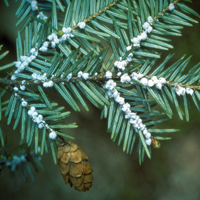Georgia
![[Photo] Georgia and the Research Work Unit Locations [Photo] Georgia and the Research Work Unit Locations](https://webarchive.library.unt.edu/eot2008/20090305052456im_/http://www.srs.fs.usda.gov/cc/images/Georgia_cc06.gif)
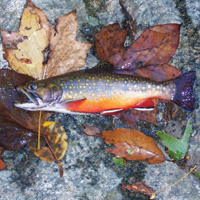 |
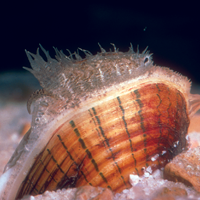 |
|
Impacts of Eastern Hemlock Mortality on Southern Appalachian Ecosystem |
Southern Appalachian Trout Distribution in a Warmer Climate In the Southern Appalachians, native brook trout and introduced rainbow and brown trout are highly prized for their existence and for recreational fishing. ...more... |
Context-Specific Effects of Severe Drought on Freshwater Mussel Communities |
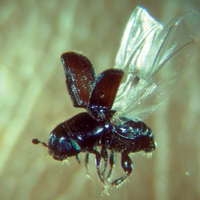 |
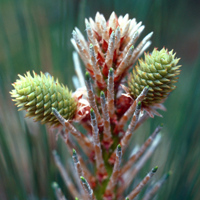 |
 |
Restoration of Degraded Shortleaf Pine Ecosystems |
Genetics of Loblolly Pine |
Predicting Acorn Production |
 |
 |
 |
Using Fire to Prevent Fire |
Figured Wood and the Practice of Sustainable Forestry The birdseye grain pattern in sugar maple is a rare yet valuable variation of this important timber species. ...more... |
Advanced Technology Used to Monitor Forest Change Many forest changes are lost in the background at a distance, but an isolated change may be part of a broader pattern when viewed from afar. ...more... |
 |
 |
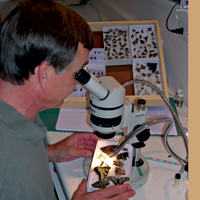 |
| IUFRO Interdivisional Conference on Forest Landscape Restoration An interdivisional conference on Forest Landscape Restoration was held in Seoul, Korea from 14 to 19 May 2007. ...more... |
A New Phase Change in Landscape Dynamics Most human impacts on forests and grasslands are mediated by land-use changes that occur as a result of population increases and new home construction in undeveloped areas or semi-natural landscapes. ...more... |
Impacts of Fire and Invasive Species on Pollinators in Forests Jim Hanula, a research entomologist in Athens, GA, determined which method of removing privet from riparian forests would move forests most quickly to the desired future condition. ...more.. |
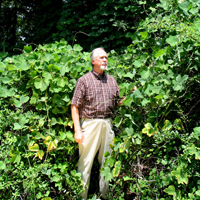 |
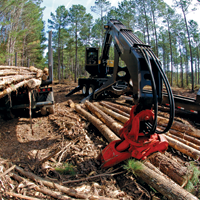 |
 |
| Data Query Tool for Invasive Plant Inventory on FIA Plots In 2001, the SRS Forest Inventory and Analysis (FIA) program started systematically surveying FIA plots for the presence and relative abundance of more than 25 non-native invasive plants. ...more... |
Timber Product Output (TPO) in the South in 2005 The South’s forest industry is a multi-billion dollar economic engine that employs hundreds of thousands of employees across the region. ...more... |
Defining Socially-Optimal Fuel Programs One of the most important and elusive issues regarding fire management is defining the “best” amount of fuel treatments to apply to a forested landscape. ...more... |
 |
 |
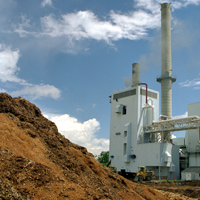 |
| Production and Costs of Biomass Removal from National Forest Lands The National Forests in Alabama are seeking non-traditional ways to remove unmerchantable material to reduce fuels and improve forest health and wildlife habitat. ...more... |
Differences between African American and Hispanic Visitation to National Forests Recent data from the Forest Service's on-site National Visitor Use Monitoring Survey (NVUM) shows that visits made by African Americans ...more... |
Southern Biofuels Assessment Program Woody biomass is primarily a raw material for either structural wood-based composites or as a thermal feedstock for the generation of energy. ...more.. |
 |
 |
|
| Recreation Visits to Wilderness and Primitive Areas Station researchers, using data from the Census, the National Visitor Use Monitoring Project, and the National Survey on Recreation and the Environment developed models to examine national participation and use of wilderness and primitive areas for outdoor recreation. ...more... |
National Leader in Recreation Research For over 30 years the Forest Service and the Recreation Research Unit in Athens, Georgia has been a recognized leader in forming partnerships to address needs for information and technology to support better policy and management of public lands. ...more... |
Other Accomplishments
- Smoke Forecasts for Southern Wildfires—The smoke management team of the Southern Research Station has begun producing daily forecasts that reflect smoke concentrations over the next 72 hours. (read the details)
- Georgia/Florida Wildfire Rapid Assessment Impact Analysis—During the spring of 2007, approximately 553,000 acres burned from south of Waycross, GA through the Okefenokee National Wildlife Refuge into Florida. (read the details)
- Biology and Management of a New Invasive Beetle Killing Bay and Laurel Trees—Southern Research Station scientists are studying a newly introduced beetle which carries a fungus causing mortality of Bay and Laurel trees in GA, SC, and FL. (read the details)
- Forest Inventory and Analysis—Researchers in the FIA unit have been conducting annual inventories in cooperation with the Georgia Forestry Commission since 1998. (read the details)
Research Accomplishments in Georgia
Impacts of Eastern Hemlock Mortality on Southern Appalachian Ecosystems
Hemlock woolly adelgid (HWA) is a non-native invasive pest that impacts eastern and Carolina hemlocks. First reported in the 1950s in the Northeast, HWA has spread to the Southern Appalachian region of northern Georgia, western North Carolina, and southern Virginia. Without control, hemlocks typically die within about five years after infestation. Neither natural predators nor host resistance have stopped the spread. Hemlocks serve important ecological roles in the Southern Appalachians. They are a keystone species in riparian areas, providing critical habitat for birds and other animals, and shading streams to maintain cool water temperatures required by trout and other aquatic organisms. We quantified the impacts of hemlock mortality on hydrological process and predict that annual transpiration will be reduced by 10 percent, and winter and spring transpiration by 30 percent. We expect increases in streamflow and soil moisture may subsequently impact nutrient and carbon cycling processes. It is likely that no other species will fill the ecohydrological role of eastern hemlock if widespread mortality occurs. Chelcy Ford (cford@fs.fed.us)
Back to top
Southern Appalachian Trout Distribution in a Warmer Climate
In the Southern Appalachians, native brook trout and introduced rainbow and brown trout are highly prized for their existence and for recreational fishing. Distribution of wild trout is limited by temperature and is expected to be limited further by a warmer climate. Southern Station scientists produced a regional map of current wild trout habitat and developed models to project future distributions over a range of increased temperature. If predictions of the Hadley Global Circulation Model (GCM) are assumed, temperature in this region would increase by 2.3o C and approximately 53 percent of trout habitat would be lost. If the more extreme Canadian GCM prediction of a 5.5o C temperature increase is used, 97 percent would be lost. Fragmentation would increase, leaving populations in small isolated patches vulnerable to extirpation because recolonization is unlikely. Patricia A. Flebbe (pflebbe@fs.fed.us)
Back to top
Context-Specific Effects of Severe Drought on Freshwater Mussel Communities
Freshwater mussel populations are often small and fragmented due to stream and landscape degradation. Isolated populations are highly vulnerable to natural disturbance. We studied five small stream sites on Bankhead National Forest heavily impacted by severe drought in 2000; one site dried almost completely and four sites experienced total or near cessation of flow. Three large stream sites retained flow and experienced minor streambed exposure. In small streams, mussel density before and after the drought declined by 65-83 percent. Most mussel species declined by similar percentages. Likelihood of survival was mostly a function of pre-drought abundance. Assemblage composition changed primarily due to loss of rare species, resulting in a shrinking species pool. We found no evidence for changes in total abundance or composition in large streams that continued to flow. Mussels are also highly sensitive to secondary effects of drought, most likely low levels of dissolved oxygen caused by low flow, warm temperatures, and high biological oxygen demand. Wendell R. Haag (whaag@fs.fed.us) and Melvin L. Warren (mwarren01@fs.fed.us)
Back to top
Restoration of Degraded Shortleaf Pine Ecosystems
Interactions among past land use, fire exclusion, drought, and southern pine beetle have caused substantial pine mortality and degradation of pine/hardwood stands in the southern Appalachians. Land managers are now challenged with the task of (1) reducing wildfire risk from widespread dead, fallen, and dying trees, (2) restoring beetle-killed forests, and (3) reducing the potential for development of stand conditions that promote increased fire risk. Land managers need information on management options that will accomplish these three goals in cost effective and practical ways. We studied the effectiveness of prescribed fire as a restoration tool in degraded shortleaf pine/bluestem ecosystems and determined that while understory burning does not adversely impact water quality, long-term site productivity, or forest floor dwelling macroinvertebrates, fire alone is not sufficient to create conditions required to regenerate shortleaf pine or increase bluestem abundance. Our current research is examining the effectiveness of more aggressive treatments, such as felling dead pines prior to burning, followed by planting shortleaf pine seedlings and seeding warm season grasses. Katherine Elliott (kelliot@fs.fed.us)
Back to top
Genetics of Loblolly Pine
Reference karyotype and cytomolecular maps are pre-requisite tools for extensive genome research. The karyotype describes the general features and landmarks of a species’ complement of chromosomes, while the cytomolecular map locates the landmarks to specific positions on each chromosome. SRS scientists have developed and published the first karyotype and cytomolecular map for loblolly pine using data from multiple cells of multiple families of loblolly pine. Comprehensive genetic and physical maps along with a complete DNA sequence of loblolly pine are currently the highest priority needs within the conifer genome community. Maps and sequences will allow genome researchers to discover at the gene level what makes a conifer different from a hardwood and to develop advanced technologies for improving the quality and quantity of wood-based products. Nurul Faridi (nfaridi@fs.fed.us) and Dana Nelson (dananelson@fs.fed.us)
Back to top
Predicting Acorn Production
Acorn crop sizes vary considerably among oak species, years, and places. This affects oak regeneration and wildlife species that depend on acorns for food. However, use of different methods to index acorn crop size makes comparisons among States difficult. Bent Creek scientists partnered with the North Carolina Wildlife Resources Commission (NCWRC) to share expertise and data. They used 21 years of acorn data from visual surveys conducted by the NCWRC in western North Carolina, to develop predictive equations for hard mast indices based on the proportion of trees bearing acorns. The proportion of trees bearing acorns can be used as a stand-alone index of acorn production, as well. By substituting this faster and simpler survey method over the labor-intensive counting of twigs and acorns used in some other visual survey methods, land managers can use the time savings to sample more trees to improve hard mast index accuracy. Katie Greenberg (kgreenberg@fs.fed.us)Back to top
Using Fire to Prevent Fire
As climate changes and forest fuels accumulate to unprecedented levels, large highly-destructive wildfires have become disturbance events of increasing frequency and severity in the South. Their increasing prevalence not only poses a direct risk to life, property and natural resources, but the increasing expenditures required for their suppression indirectly undermines resource stewardship efforts by diverting a significant proportion of agency budgets to large-scale emergency activities. By evaluating the pre-emptive use of fire (i.e., prescribed burning) and mechanical and chemical alternatives (i.e., fire surrogates), it is anticipated that more effective prevention strategies utilizing these treatments can be developed and applied to diminish the multiple threats posed by wildfire. Station researchers have tested mechanical and fire treatments in a variety of southern ecosystems in the South. Studies in the Florida flatwoods suggest that saw-palmetto, the main understory and midstory fuel in this ecosystem, cannot be effectively reduced by fire-only treatments; prescribed burning must be followed by mechanical treatment to reduce palmetto dominance and abate fire risk. Findings on in Alabama indicate that hardwood trees and shrubs are best controlled by mechanical treatment followed by repeated prescribed fires. Mechanical treatment alone is insufficient because of rapid regrowth, and using fire alone would require several decades to achieve fire hazard abatement goals. Dale Brockway (dbrockway@fs.fed.us) and Ken Outcalt (koutcalt@fs.fed.us)
Back to top
Figured Wood and the Practice of Sustainable Forestry
The birdseye grain pattern in sugar maple is a rare yet valuable variation of this important timber species. A recent Station publication reviewed birdseye grain in sugar maple and suggested how this highly prized commodity can increase options for sustainable forestry and made a number of management recommendations. First, land managers should be able to recognize birdseye maples in the field, either as standing timber or before the logs are fully processed. This will help ensure that economic losses do not result from mistakenly discarded or underutilized timber. Second, residual timber containing figured wood should be carefully protected to avoid loss of tree quality following logging. Third, management of the residual timber may need to be modified to help ensure continued production of birdseye, which in turn may prove more compatible with certain silvicultural strategies such as managing for old-growth-like conditions. Many of the lessons learned on birdseye maple also apply to other figured grains, such as curly grains or burlwood. Don Bragg (dbragg@fs.fed.us)
Back to top
Advanced Technology Used to Monitor Forest Change
Many forest changes are lost in the background at a distance, but an isolated change may be part of a broader pattern when viewed from afar. Finding a proper balance between detail and perspective challenges those who monitor forest conditions over broad areas. Station scientists at the Eastern Forest Environmental Threat Assessment Center have teamed up with NASA’s Stennis Space Center, Oak Ridge National Laboratory, and other FS technology centers to develop an early warning system that uses multiple sensors operating at multiple scales. Advanced computer algorithms on supercomputers create a composite map every eight days. Every 500 square-meter pixel in the map is categorized using explicit information about topography and climate in addition to MODIS values. By comparing a pixel with its previous states, one can detect unexpected transitions. Multiple shifts or a recognizable pattern could trigger additional examination by specialized airborne sensors or ground crews. NASA is currently testing hyperspectral sensors for this purpose. William H. Hargrove (whargrove@fs.fed.us)
Back to top
IUFRO Interdivisional Conference on Forest Landscape Restoration
An interdivisional conference on Forest Landscape Restoration was held in Seoul, Korea from 14 to 19 May 2007. A total of 111 scientific papers were presented orally (71) or as posters (40) in three days, followed by one- or three-day post-conference field trips. About 300 participants attended the Conference, representing 27 countries from Asia, Australia and Oceania, the Americas, and Europe. The objective of the Conference was to examine the scientific basis for forest landscape restoration and its linkages to practice and policy. Presentations focused on contributions from ecological and social sciences, including models to integrate the approaches and case studies to illustrate restoration practices. A special workshop on tools provided participants an opportunity to discuss how to actually accomplish landscape restoration on the ground. A proceedings was published by the Korea Forest Research Institute and distributed at the meeting; pdfs of the papers can be downloaded from the conference Web site (http://www.srs.fs.usda.gov/korea/). A book from the conference, tentatively titled “Forest Landscape Restoration: Integrating Ecological and Social Sciences” is in preparation. Selected papers will be published as special issues of one or more journals. John Stanturf (jstanturf@fs.fed.us)
Back to top
A New Phase Change in Landscape Dynamics
Most human impacts on forests and grasslands are mediated by land-use changes that occur as a result of population increases and new home construction in undeveloped areas or semi-natural landscapes. In order to understand these changes and predict future impacts on amenities like biodiversity and water quality, landscape ecologists need reliable reference standards to compare with observed patterns. Such standards need to take into account certain types of phase changes (abrupt shifts in the state of an ecosystem) that can occur as land-use intensifies in a given area. In the past, percolation theory has provided a rigorous basis for interpreting changes in popular measures of habitat quality such as average forest patch size and forest connectivity across a landscape. Southern Research Station scientists at the Eastern Forest Environmental Threat Assessment Center (EFETAC) and the European Commission have identified a new type of phase change that occurs as habitat edges switch abruptly from interior to exterior edges. This contextual phase change occurs at levels of land-use change that are much lower than that reflected in percolation indices, which improves the sensitivity with which land-use changes in forested and grassland landscapes are measured. Kurt Riitters (kriitters@fs.fed.us)
Back to top
Impacts of Fire and Invasive Species on Pollinators in Forests
Jim Hanula, a research entomologist in Athens, GA, determined which method of removing privet from riparian forests would move forests most quickly to the desired future condition. One privet removal treatment resulted in a 4-fold increase in pollinator diversity and a 10-fold increase in pollinator abundance after only one year. This innovative project has served to develop management strategies that favor pollinator abundance and raise awareness about the damaging effects of invasive plants on pollinators. In addition, Dr. Hanula studied the impacts of fire and fire surrogates on pollinators in the Appalachian Mountains of North Carolina and coastal plain of Alabama. In partnership with the University of Georgia, Dr. Hanula initiated this research from a need to insure that forest management practices did not negatively affect pollinators. Dr. Hanula found that a combination of cutting the shrub layer followed by prescribed fire in the mountains greatly increased the diversity and abundance of pollinators including a rare butterfly, the diana fritillary. Similar treatments on the coastal plain showed that these management practices did not have a negative effect on pollinators there. For his efforts, Dr. Hanula received national recognition in the form the USDA Forest Service 2007 Celebrating Wildflowers Award for Excellence in Pollinator Conservation. Jim Hanula (Jhanula@fs.fed.us)
Back to top
Data Query Tool for Invasive Plant Inventory on FIA Plots
In 2001, the SRS Forest Inventory and Analysis (FIA) program started systematically surveying FIA plots for the presence and relative abundance of more than 25 non-native invasive plants. Because this information has been collected regionally, the data have not been publicly available through the national FIA data Web site. However, a new tool that has been made available through the SRS FIA Web site (http://srsfia2.fs.fed.us)/nonnative_invasive/Southern_Nonnative_Invasives.htm) now enables users of FIA data to access data on non-native invasive plant occurrence on forestland by county. Other details also are provided to enable knowledgeable individuals to map, model, and analyze these regional observations in combination with tree, forest condition, and plot attributes from the national FIA Web site. Potential users include the US Geological Survey’s National Biological Information Infrastructure and the National Institute of Invasive Species Science, FS Forest Health Protection and other Federal agencies, The Nature Conservancy’s NatureServe, and State and regional exotic pest plant councils. Ray Sheffield (rsheffield@fs.fed.us) and Ted Ridley (tridley@fs.fed.us)
Back to top
Timber Product Output (TPO) in the South in 2005
The South’s forest industry is a multi-billion dollar economic engine that employs hundreds of thousands of employees across the region. In most southern States, forest industry ranks in the top three manufacturers of industrial products. The southern States account for nearly 60 percent of the Nation’s total timber product output. The SRS Forest Inventory and Analysis (FIA) unit and the State forestry agencies across the South have completed the 2005 forest industry surveys for roundwood harvest and consumption in the southern US. The study shows that industrial TPO in the southern States jumped from 8.2 to 8.7 billion cubic feet between 2003 and 2005. Softwood product output was up 6 percent to 6.4 billion cubic feet and accounted for nearly three-quarters of total product output. In August, the 2005 TPO data was made available at the FIA website, at http://srsfia2.fs.fed.us)/php/tpo2/tpo.php. This information will be used not only by the State forestry agencies but also by forest industry analysts and economists, university personnel, and individuals interested in how the forest resource is being utilized. The annual Southern Pulpwood report for 2005 has been published. Individual State-level TPO assessments for 2005 will be published during the next FY. Tony Johnson (tjohnson09@fs.fed.us)
Back to top
Defining Socially-Optimal Fuel Programs
One of the most important and elusive issues regarding fire management is defining the “best” amount of fuel treatments to apply to a forested landscape. The definition of optimal treatments is difficult because: (1) the effectiveness of treatments are difficult to measure and vary over time, (2) treatment costs are variable and are influenced by the scale of operations, (3) the damages from fire, which span timber, human health, tourism, and personal property losses, are complex and depend on the region, and (4) future fire occurrences are inherently uncertain. Station researchers have, over the course of five years, completed a series of studies to address each of the elements of this large question, and for the first time, have provided a complete answer. Using data on forest resources, meteorology, fire occurrence, and economic impacts within a probabilistic modeling framework, they have built a state-of-the-science assessment of prescribed burning to address how prescribed fire programs affect total social welfare at a broad scale. Their capstone analysis, applied to Volusia County in Florida, defines the optimal prescribed burning regime for a broad range of potential fire scenarios. The results indicate that, not only does the current prescribed burning regime generate gains in social welfare, but that these gains would exceed the costs of burning for a considerable expansion in the prescribed burning program. While landowners currently burn about 4-5 percent of forests per year, the socially optimal treatment is approximately 13 percent of forests per year. Jeff Prestemon (jprestemon@fs.fed.us)
Back to top
Production and Costs of Biomass Removal from National Forest Lands
The National Forests in Alabama are seeking non-traditional ways to remove unmerchantable material to reduce fuels and improve forest health and wildlife habitat. Two Districts, the Shoal Creek and the Oakmulgee, have implemented biomass removal projects to explore new methods of accomplishing their land management goals. In 2006, biomass was chipped and delivered to a pulp mill for fuel chips. Building on the success of that project, a new collaborative project was initiated with support from the FPL Biomass Grants program. The new study is examining thinning and processing as feedstock for co-milling in coal-fired power plants. A key obstacle has been to find appropriate in-woods processing equipment that would produce acceptable chip material for the power plant. A prototype chipping machine was developed by a manufacturer specifically to create small “chips”. Southern Station researchers are studying the production rates and costs of chipping and grinding this unmerchantable material into an energy product with the new machine as a potential cost-effective alternative to mulching, piling, or burning the material. Dana Mitchell (danamitchell@fs.fed.us)
Back to top
Examination of Differences between African American Visitation to National Forests in the South and Hispanic Visitation to National Forests in the Southwest
Recent data from the Forest Service’s on-site National Visitor Use Monitoring Survey (NVUM) shows that visits made by African Americans to national forests in the South account for very low visitation percentages in the region. This is surprising given that African Americans are highly concentrated in the South, and that both rural and urban black populations live proximal to national forests in several southern States. In contrast, Hispanic visits to national forests in the Southwest are high, relative to their population proportion. We examined additional national level household data from the National Survey on Recreation and the Environment (NSRE) relating to awareness of Federal lands and management to help understand the discrepancy between Hispanic and Black recreational use of Federal lands. We hypothesized that awareness of Federal agencies, knowledge of management objectives, and attitudes about user fees would explain Black/Hispanic visitation differences; however, strong differences remained after accounting for these factors. To help understand these differences, more precise data may be obtained from both institutional and personal factors, including regional differences in agency support for visitor diversity; sub-cultural values as they relate to wild land places; and private land ownership in each region for the respective groups. C. Y. Johnson (cjohnson09@fs.fed.us)
Back to top
Southern Biofuels Assessment Program
Woody biomass is primarily a raw material for either structural wood-based composites or as a thermal feedstock for the generation of energy. One of the ways energy can be recovered from wood is by a thermochemical process in which wood particles are subjected to extremely high temperatures in an anaerobic environment. This process yields synthesis gas (“syngas”) that is a mixture of methane, hydrogen, carbon monoxide, and carbon dioxide. Syngas can be used as a gaseous fuel or as the starting material in a secondary reaction that yields liquid transportation fuels such as ethanol, gasoline, or diesel. There exists two basic obstacles to the production of bioenergy from woody biomass: (1) the lack of information regarding the chemical and physical composition of woody biomass from southern forests and plantations; (2) lack of efficient conversion technologies. Southern Research Station scientists are undergoing an extensive study over the next 5-year period that will investigate three areas of bioenergy research. The first area will be woody raw material characterization, done in conjunction with other work such as forest genetics, tree breeding and physiology research with genomics technology to determine the effects of specific genes and gene combinations on bioenergy traits and overall feedstock performance. Secondly, we will evaluate the efficacy of various conversion techniques (gasification, pyrolysis, fermentation) in relation to the chemical/physical composition of the woody biomass. Finally, we will evaluate the impact of biomass removals on fuels loading, soil quality, water quality, and forest ecosystem health. Les Groom (lgroom@fs.fed.us)
Back to top
Recreation Visits to Wilderness and Primitive Areas
Station researchers, using data from the Census, the National Visitor Use Monitoring Project, and the National Survey on Recreation and the Environment developed models to examine national participation and use of wilderness and primitive areas for outdoor recreation. Their findings corroborated previous studies suggesting that racial minorities, immigrants, urbanites, and females participate less in primitive area recreation. In related work, they examined the relationship between visitation and personal, structural, and psychological constraints to wildland recreation use. Seventeen structural, personal, and psychological constraints related to health, facilities, socioeconomic standing, and other personal factors were examined using regression methods. Results revealed minorities, women, lower levels of income and education, and elderly populations were more likely to perceive they were significantly constrained from visiting wilderness. Using Census data and estimated models, the researchers projected future participation and use in order to assess recreation pressure on wildlands. In general, their findings indicate that over the next 40 years, wildland recreation users and use will increase but at a rate less than general population growth. In fact, per capita participation in wildland recreation is expected to drop more than 15 percent. Nevertheless, when combined with a nearly 50 percent increase expected in the general population, a net increase in participants of about 25 percent and about a 20 percent increase in wildland site visits annually. Furthermore, if management and acculturation can influence a reduction in perceived constraints by certain demographics, the increases are likely to be greater. The increase in site visits combined with a dwindling amount of wildland acreage due to development pressures will present challenges to land managers and to the Agency’s goal of providing high-quality outdoor recreation opportunities while sustaining natural system quality. J. M. Bowker (mbowker@fs.fed.us)
Back to top
National Leader in Recreation Research
For over 30 years the Forest Service and the Recreation Research Unit in Athens, Georgia has been a recognized leader in forming partnerships to address needs for information and technology to support better policy and management of public lands. This on-going partnership has involved multiple Federal agencies, State associations, private associations and universities. Projects have included the Federal Estate Visitors Survey, the Public Area Recreation Visitors Survey, the Customer Use Survey, the National Visitor Use Monitoring Survey, the National Recreation Survey, and most recently the National Survey on Recreation and the Environment (NSRE). The NSRE involves the Forest Service, National Oceanic and Atmospheric Administration, the Environmental Protection Agency, the United States Coast Guard, the National Park Service, the Bureau of Land Management, other Federal agencies, the National Association of Recreation Resource Planners, the University of Georgia, the University of Tennessee, and the State University of New York. H. Ken Cordell (kcordell@fs.fed.us)
Back to top
Other Accomplishments
Smoke Forecasts for Southern Wildfires
The smoke management team of the Southern Research Station has begun producing daily forecasts that reflect smoke concentrations over the next 72 hours. These forecasts combine detailed weather forecasts with information about specific fires to estimate the amount of smoke produced and where that smoke will be transported. The smoke forecasts focus on a specific class of pollutant, particulate matter smaller than 2.5 microns in diameter, a pollutant measured by the EPA as part of the National Ambient Air Quality Standards. Maps are provided on http://www.shrmc.org/ge.
Back to top
Georgia/Florida Wildfire Rapid Assessment Impact Analysis
During the spring of 2007, approximately 553,000 acres burned from south of Waycross, GA through the Okefenokee National Wildlife Refuge into Florida. Forest Inventory and Analysis (FIA) program data provided a convenient means to quickly assess timberland area and volume affected. This assessment also used the National Land Cover Data (NLCD) to stratify FIA plots. Results provided timber volume by ownership, forest products categories, and pre-commercial forest area. Mortality factors were then applied along with prevailing timber prices to assess economic impacts.
Back to top
Biology and Management of a New Invasive Beetle Killing Bay and Laurel Trees
Southern Research Station scientists are studying a newly introduced beetle which carries a fungus causing mortality of Bay and Laurel trees in GA, SC, and FL. Recent work has focused on determining the distribution of the beetle and disease in the South, and identifying other susceptible tree species (sassafras and avocado). The fungus causing the disease has been identified, and a powerful attractant, useful in monitoring (and perhaps controlling) the beetle has been studied.
Back to top
Forest Inventory and Analysis
Researchers in the FIA unit have been conducting annual inventories in cooperation with the Georgia Forestry Commission since 1998. A total of $549,898 was provided to the State for annual inventory field data collection. A five-year report is being developed. Inventory data is available electronically through 2005.
Back to top
 Southern Research Station Headquarters - Asheville, NC
Southern Research Station Headquarters - Asheville, NC
![[Images] Five photos of different landscape [Images] Five photos of different landscape](https://webarchive.library.unt.edu/eot2008/20090305052456im_/http://www.srs.fs.usda.gov/images/imstr1.jpg)


